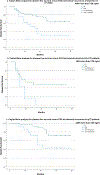Anti-Müllerian hormone: a novel biomarker for aggressive prostate cancer? Emerging evidence from a prospective study of radical prostatectomies
- PMID: 38127275
- PMCID: PMC11190032
- DOI: 10.1007/s42000-023-00520-z
Anti-Müllerian hormone: a novel biomarker for aggressive prostate cancer? Emerging evidence from a prospective study of radical prostatectomies
Abstract
Purpose: Prostate cancer patients are a heterogeneous group as regards the aggressiveness of the disease. The relationship of steroid hormones with the aggressiveness of prostate cancer is unclear. It is known that the anti-Müllerian hormone (AMH) inhibits prostate cancer cell lines in vitro. The aim of this study is to investigate the relationship of AMH and steroid hormones with the aggressiveness of prostate cancer.
Methods: This was a prospective study of consecutive radical prostatectomy patients. We measured the following hormones: total testosterone, sex hormone-binding globulin, albumin, luteinizing hormone, follicle-stimulating hormone, estradiol, dehydroepiandrosterone sulfate, androstenedione, and AMH. The minimum follow-up after radical prostatectomy was 5 years. For the aggressiveness of prostate cancer, we considered the following three variables: post-operative Gleason score (GS) ≥ 8, TNM pΤ3 disease, and prostate-specific antigen (PSA) biochemical recurrence (BCR).
Results: In total, 91 patients were enrolled. The mean age and PSA were 64.8 years and 9.3 ng/dl, respectively. The median post-operative GS was 7. Low AMH blood levels were correlated with higher post-operative GS (p = 0.001), as well as with PSA BCR (p = 0.043). With pT3 disease, only albumin was (negatively) correlated (p = 0.008). ROC analysis showed that AMH is a good predictor of BCR (AUC 0.646, 95% CI 0.510-0.782, p = 0.043); a cutoff value of 3.06 ng/dl had a positive prognostic value of 71.4% and a negative prognostic value of 63.3% for BCR. Cox regression analysis showed that AMH is a statistically significant and independent prognostic marker for BCR (p = 0.013). More precisely, for every 1 ng/ml of AMH rise, the probability for PSA BCR decreases by 20.8% (HR = 0.792). Moreover, in Kaplan-Meier analysis, disease-free survival is more probable in patients with AMΗ ≥ 3.06 ng/ml (p = 0.004).
Conclusions: Low AMH blood levels were correlated with aggressive prostate cancer in this radical prostatectomy cohort of patients. Therefore, AMH could be a prognostic biomarker for the aggressiveness of the disease.
Keywords: Anti-Müllerian hormone (AMH); Biomarker; Prostate cancer; Radical prostatectomy.
© 2023. The Author(s), under exclusive licence to Hellenic Endocrine Society.
Conflict of interest statement
Figures


Similar articles
-
Long-term cancer control outcomes in patients with clinically high-risk prostate cancer treated with robot-assisted radical prostatectomy: results from a multi-institutional study of 1100 patients.Eur Urol. 2015 Sep;68(3):497-505. doi: 10.1016/j.eururo.2015.06.020. Epub 2015 Jun 26. Eur Urol. 2015. PMID: 26119559
-
Assessing the Optimal Timing for Early Salvage Radiation Therapy in Patients with Prostate-specific Antigen Rise After Radical Prostatectomy.Eur Urol. 2016 Apr;69(4):728-733. doi: 10.1016/j.eururo.2015.10.009. Epub 2015 Oct 21. Eur Urol. 2016. PMID: 26497924
-
Predictive factors and oncological outcomes of persistently elevated prostate-specific antigen in patients following robot-assisted radical prostatectomy.J Robot Surg. 2017 Mar;11(1):37-45. doi: 10.1007/s11701-016-0606-8. Epub 2016 May 31. J Robot Surg. 2017. PMID: 27245233
-
Tertiary Gleason pattern in radical prostatectomy specimens is associated with worse outcomes than the next higher Gleason score group in localized prostate cancer.Urol Oncol. 2018 Apr;36(4):158.e1-158.e6. doi: 10.1016/j.urolonc.2017.12.003. Epub 2017 Dec 27. Urol Oncol. 2018. PMID: 29288003
-
Follicle-stimulating hormone and the pituitary-testicular-prostate axis at the time of initial diagnosis of prostate cancer and subsequent cluster selection of the patient population undergoing standard radical prostatectomy.Urol Int. 2013;90(1):45-55. doi: 10.1159/000343430. Epub 2012 Nov 2. Urol Int. 2013. PMID: 23128438
References
-
- Tolkach Y, Kristiansen G (2018) The heterogeneity of prostate cancer: a practical approach. Pathobiology 85(1–2):108–116 - PubMed
-
- Hung SC, Yang CK, Cheng CL, Ou YC (2017) Long-term oncologic outcomes of robotic-assisted radical prostatectomy by a single surgeon. Anticancer Res 37(8):4157–4164 - PubMed
-
- Malaeb BS, Rashid HH, Lotan Y, Khoddami SM, Shariat SF, Sagalowsky AI et al. (2007) Prostate cancer disease-free survival after radical retropubic prostatectomy in patients older than 70 years compared to younger cohorts. Urol Oncol 25(4):291–297 - PubMed
MeSH terms
Substances
Grants and funding
LinkOut - more resources
Full Text Sources
Medical
Research Materials
Miscellaneous

